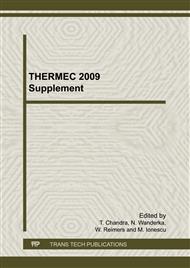p.102
p.107
p.112
p.118
p.124
p.130
p.136
p.142
p.147
Texture Evolution in Linear Friction Welded Ti-6Al-4V
Abstract:
The linear friction welding (LFW) behavior of Ti-6Al-4V, a commercial α + β titanium alloy, was investigated using oscillation frequencies ranging from 30-70 Hz and axial pressures from 50-110 MPa. LFW samples were examined using electron backscattered diffraction (EBSD) to relate the texture to the welding parameters and to the estimated strain and strain rate. Characterization of the welds included analysis of the microstructure of the weld and of the thermomechanically affected zones (TMAZ) in relation to the parent material.
Info:
Periodical:
Pages:
124-129
Citation:
Online since:
January 2010
Authors:
Price:
Сopyright:
© 2010 Trans Tech Publications Ltd. All Rights Reserved
Share:
Citation:


